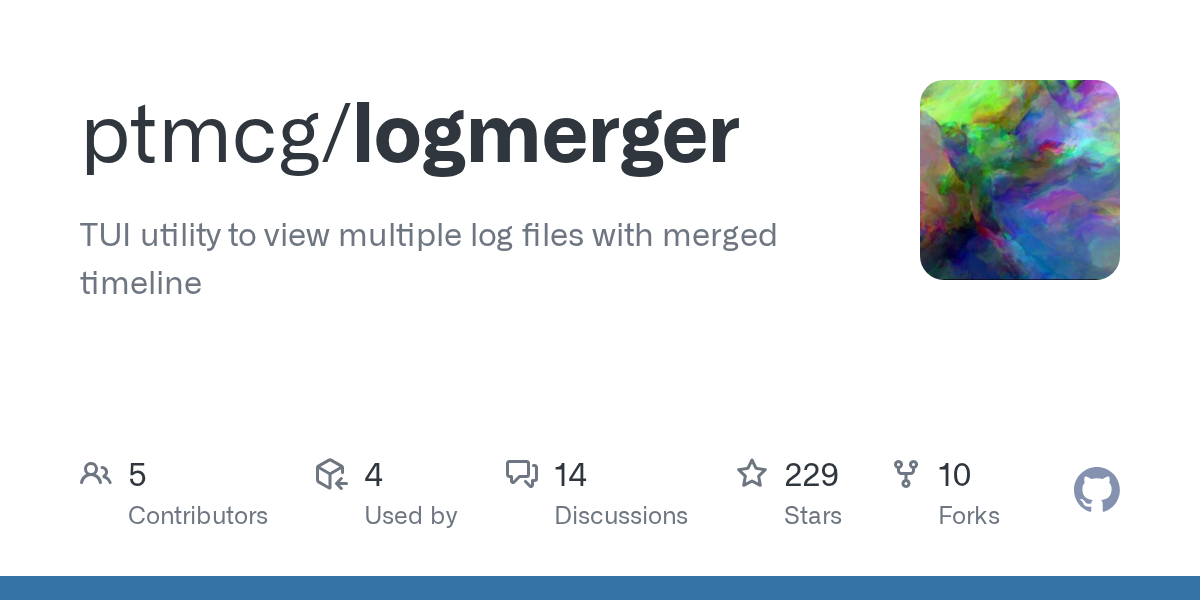logmerger: A TUI Utility for Merging and Viewing Multiple Log Files

Summary
logmerger is an intuitive TUI utility built with Python, designed to streamline the process of viewing and analyzing multiple log files. It merges log entries from various sources into a single, chronologically ordered timeline, making it significantly easier to debug and understand system behavior across different logs. This tool enhances log analysis by providing an interactive, unified view.
Repository Info
Tags
Click on any tag to explore related repositories
Introduction
logmerger is a powerful TUI (Text User Interface) utility written in Python, designed to simplify the complex task of analyzing multiple log files simultaneously. It intelligently merges log entries from various sources into a single, chronologically ordered timeline, providing a unified view for easier debugging and system monitoring. This tool is particularly useful for developers and system administrators who need to correlate events across different log streams.
Installation
To get started with logmerger, you can easily install it using pip:
pip install logmerger
This command installs logmerger as a shell/console command, allowing you to run it directly. For additional support, such as merging pcap files, install with the [pcap] extra:
pip install logmerger[pcap]
Examples
logmerger offers both an interactive TUI and a command-line output option, catering to different analysis needs.
Interactive TUI
To view logs interactively, simply run logmerger with your log files:
logmerger log1.txt log2.txt
This command opens a browsable merged display, powered by the textual Python library, allowing you to navigate through your logs with ease.

(Note: Press 'h' within the TUI for help on all key commands.)
Output to Stdout
You can also direct the merged logs to standard output or a file using the --output option. For example, to send to stdout:
logmerger --output - log1.txt log2.txt
This will produce a clean, merged text output like this:
Timestamp Files/Log1.Txt Files/Log2.Txt
????????????????????????????????????????????????????????????????????????????????????????????????????
2023-07-14 08:00:01.000 WARN Connection lost due to INFO Request processed
timeout successfully
2023-07-14 08:00:03.000 INFO User authentication
succeeded
2023-07-14 08:00:04.000 ERROR Request processed
unsuccessfully
Something went wrong
Traceback (last line is latest):
sample.py: line 32
divide(100, 0)
sample.py: line 8
return a / b
ZeroDivisionError: division by zero
2023-07-14 08:00:06.000 INFO User authentication DEBUG Starting data
failed synchronization
2023-07-14 08:00:08.000 DEBUG Starting data INFO Processing incoming request
synchronization
2023-07-14 08:00:11.000 INFO Processing incoming request DEBUG Performing database backup
INFO Processing incoming request
(a little more...)
2023-07-14 08:00:14.000 DEBUG Performing database backup WARN Invalid input received:
missing required field
Why Use logmerger?
logmerger stands out as an essential tool for anyone dealing with distributed systems or complex applications. Its ability to merge logs chronologically across different files eliminates the manual effort of cross-referencing timestamps, significantly speeding up debugging and incident response. The interactive TUI provides a user-friendly interface for exploration, while its support for various log formats, including compressed files, CSV, JSONL, and specialized types like pcap, makes it highly versatile. Whether you need a quick overview or detailed forensic analysis, logmerger offers a robust solution for efficient log management.
Links
- GitHub Repository: ptmcg/logmerger
- PyPI Project Page: logmerger